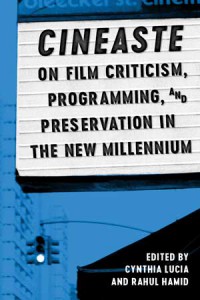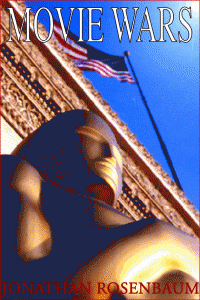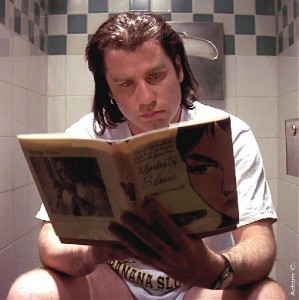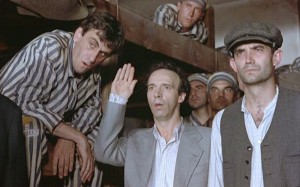From “Film Criticism in America Today: A Critical Symposium,” Cineaste 26, no. 1, 2000. This is the first of several symposia gathered in a new collection edited by Cynthia Lucia and Rahul Hamid, Cineaste on Film Criticism, Programming, and Preservation in the New Millennium, Austin: University of Texas Press, 2017. –- J.R.
Here are my replies to the following questions from Cineaste:
1. What does being a film critic mean to you? (More specifically, why do you write film criticism? Whom do you hope to reach, and what do you hope to communicate to them?)
2. What qualities make for a memorable film critique? (Do you think such critiques tend to be positive or negative in tone? Is discussing a film’s social or political aspects as important to you as its cinematic qualities and value as art or entertainment?)
3. How would you characterize the relationship between film critics and the film industry? Do you think film critics could be more influential in this relationship? How?
4. What are the greatest obstacles you face in writing the kind of film criticism you wish to write? (For example, does your publication require delivery of your copy on a short deadline after only one screening, limit the space available for your reviews, or dictate which films you should review? How difficult is it for you to keep up with all types of film releases?)
5. Do you have any pet peeves or personal frustrations that you’d like to address? Or would you like to share your critical credo or a favorite maxim about film criticism from a forerunner?
***
1. What does being a film critic mean? It means in my case having a forum to write about things that matter a great deal to me, including film—though by no means restricted to that topic. I hope to reach other people who care passionately about the same things, and what I hope to communicate above all is the passion and interest that we share.
We don’t have to agree. “I like to think of myself as an airplane, not an airport,” Jean-Luc Godard once said to me in an interview, and I feel the same way. In other words, I’d be happy in some cases if readers use me to travel somewhere—somewhere specified by them and not by me—and then get off, rather than just regard me and what I have to say as the final destination. Dialogue adds up to more than monologue—at least if it includes multiple viewpoints rather than simple assent.
It’s also true, of course, that in my criticism I’m often proselytizing on behalf of certain films and filmmakers, which means that I hope some things will be more widely seen. But that doesn’t mean that I always learn the most from the critics I agree with, or that I necessarily expect readers to take what I say without a discussion or an argument. As Manny Farber has suggested, evaluations often turn out to be the least important aspects of criticism, and I’m particularly fascinated by those moments in his own writing when you can’t even tell whether he’s ridiculing or celebrating something.
By and large, I’m most in favor of whatever takes film out of the realm of business, since just about everything in our life and culture seems bent on placing it exclusively in those terms, which I generally find both limited and monotonous. I realize it’s important for business people to keep up with film as a business, but why anyone else should care how much money someone else makes is a total mystery to me. There’s so much else to think and write about, although sometimes it becomes necessary to discuss certain aspects of business that get in the way of criticism—something I try to do in my recent book, Movie Wars: How Hollywood and the Media Limit What Films We Can See.
It’s unfortunate, moreover, that film criticism is often thought to be about film and nothing else, and is linked as such to simple consumer advice—a fairly narrow and boring activity by itself. I considered myself a writer for many years before I ever thought about writing film criticism, and for me part of the challenge and interest of writing about a film at length is often to explore related topics, such as the subject of a documentary, the novel or story or play that a fiction film is based on, what a film might have to say about a particular time or place, and so on. As far as I’m concerned, the same applies to other kinds of criticism and, for that matter, other kinds of writing.
2. “What qualities make for a memorable film critique?” Provocation, originality, information, engagement, a sense of ethics and ideological impact, insight, attention to detail, humor, good prose, a wide enough context, a feeling for what a film does both while you’re watching it and afterwards, and energy—not necessarily in that order. In fact, I’m often inclined to place information first on the list; it’s perhaps the most underrated and neglected single element in film criticism. One striking recent example among many: Rosetta, which won the top prize at Cannes in May 1999, inspired a new law in Belgium that passed six months later, “le plan Rosetta,” altering the minimum wage for teenagers. To the best of my knowledge, I was the one who actually “broke” this story—which I heard about from Cahiers du cinema‘s Bill Krohn after he learned it from a Paris colleague—in January 2000, when the film opened in Chicago, because no journalist outside Belgium, or the film’s US distributor, reported it.
One of the recurring limitations of leftist film criticism in America is its efforts to separate a film’s social and political aspects from its cinematic qualities and its value as art and entertainment—a puritanical distrust of pleasure that is frequently accompanied by a lack of interest in form. In Europe, where I lived for almost eight years, I found that the critics with the most sensitivity to form were almost invariably communists. In this country, communists and fellow travelers are more apt to be philistines about form, aesthetically if not intellectually. This often seems connected with an impoverished sense of what pleasure consists of, which Latins often seem more proficient in identifying and appreciating—such as taking the radical step of finding that art is closer to play than to work, a relatively suspect notion in American culture because art is often needlessly confused with class. But as far as I’m concerned, the best criticism is the kind that shows me how to have fun. And contrary to some of our popular notions about entertainment, this doesn’t necessarily entail shirking any moral concerns.
3. Existentially speaking, most individuals nowadays who call themselves film critics are controlled, if not literally owned, by the film industry. (Sometimes literal, or at least figurative, ownership also applies.) Given the industry’s financial resources and the eagerness of the mainstream press to cater to these resources rather than to the interests of the public this situation isn’t likely to change. It means that the “decision” of most of the press regarding which releases of Miramax are relatively important (e.g., Kids, Pulp Fiction, The Wings of the Dove, Life Is Beautiful) and which are relatively unimportant (e.g., Through the Olive Trees, The Glass Shield, The Young Girls of Rochefort, the color version of Jour de fête) is made by the Weinstein brothers, not by reviewers. Moreover, the reviewers who think otherwise—and judging from the evidence, there aren’t many—are likely to be stymied by the reluctance or refusal of Miramax to rethink its own priorities in terms of advertising or making prints, clips, or videos available. Maybe if there were a bit more independent investigation—such as a better sense of what opens abroad, or what gets “picked up” but then is made virtually invisible for one reason or another—we might have a kind of film criticism and/or film journalism worthy of the name, not a simple rubber-stamping of industry decisions. I continue to be amazed that most reviewers implicitly accept and endorse the chaotic sort of re-editing and even reshooting that is sometimes prompted by the studios’ favorite form of voodoo science, test marketing. And of course if you don’t or can’t keep up with the particulars of this process, you’re condemned in one way or another to become a part of it, by accepting its operations as the final creative decisions that matter.
Much of the blame for this rests on editors and producers who choose promotion over investigation. In the mainstream press, most material about movies is advertising of one kind or another masquerading as news, and this situation shows few signs of changing or even of being acknowledged as such. But critics might be more influential in this relationship if we had something more closely resembling a free press. By and large, the American press is allowed to be free—i.e., pluralistic and independent of studios and multicorporations—regarding its assessment of what’s important in cinema only when its influence is felt to be relatively inconsequential. Rightly or wrongly, I assume this is why Miramax hasn’t raised any fusses over my campaigns against its practices, at least to my knowledge—when it already has so many more prominent reviewers in its vest pocket, why should it care?
4. At the Chicago Reader, I consider myself unusually and inordinately fortunate in having fewer restrictions regarding deadlines, space, and choice of films to write about than any of my colleagues—or at least any of my colleagues that I’m aware of who write on a regular basis for weekly publications. This is thanks, in part, to a tradition of writing about film for the Reader that was mainly established by Dave Kehr in the 197os and 198os, a precedent for which I continue to be grateful. Since then, it’s a sad commentary on the evaluation of film criticism in the United States that every time Kehr has been hired to review films elsewhere—at the Chicago Tribune, at the New York Daily News, and most recently at City Watch—his space has been cut in half at the same time that his salary has gone up. Presumably, then, the way one becomes rich writing film criticism is learning how to speak in sound bites on TV—which in effect means to shut up and let the clips do most of the talking. (Even if what you say is thoughtful, it’s the promotional aspect that mainly registers.) A few years back, the Reader hired a second-stringer, Lisa Alspector, who currently reviews as many films for the paper as I assign to her, leaving me more time to work on my longer reviews. On the whole, I believe the biggest problem in film reviewing over time is a kind of combat fatigue that often makes one disproportionately grateful for movies that are slightly better than average. More generally, any reviewer is likely to see more releases than the average ordinary viewer, and this alters one’s overall standards and responses enormously—a factor that is seldom taken into account.
5. Most of my pet peeves have been aired above. Here’s a critical credo: the best film criticism almost always emerges from a critical community —which generally means a population of cinephiles who can hang out together and discuss movies, read one another, and/or communicate with others by phone or fax or e-mail. Some colleagues insist that they don’t like to discuss films or read other criticism before writing their reviews, but it’s my conviction that isolated responses tend to be relatively impoverished. And in the past, many critics have reflected the communities they emerged from and/or nourished: in an American context, think of James Agee’s and Manny Farber’s wide range of references to other arts and artists, Andrew Sarris’s allusions to other auteurists, and Pauline Kael’s use of the royal “we” and the ways she quoted friends and companions. I know that these practices are often treated negatively, but I tend to think of them as the soil from which valuable insights grow. In a French context, there’s Andre Bazin, the future New Wave directors, and Serge Daney—not to mention eccentrics like Henri Langlois and Noël Burch who also need to be seen as part of collective situations. Even Harry Alan Potamkin, a neglected American critic of the 1920s and 1930s, was something of a yenta, and so was Sergei Eisenstein, for that matter. Of course, a lone figure such as John Simon also gossips, but he’s more likely to get his facts wrong—such as his recent assertion in National Review that Raid Ruiz is a homosexual. (By the same token, it has to be said that the solitary expert is both a myth and a kind of cottage industry that needs to be retired, because it rarely leads to a healthy environment. Think of how much fresher things might be, for instance, if we had four or five books about John Cassavetes by four or five separate American critics instead of just one.)
Colleagues who say that they don’t want their ideas stolen usually don’t have many ideas to begin with. (It’s a different matter, of course, for reviewers who for one reason or another don’t want their opinions about movies leaked in advance—but opinions aren’t the same things as ideas or criticism.) Personally, I sometimes love it if an idea of mine gets sto-len—which admittedly doesn’t happen too often—because it’s one way of having influence. I also have to admit that a major influence in my writing is the feedback as well as the pieces of information I get fed by readers. As I put it in my collection Placing Movies: The Practice of Film Criticism, “Whether acknowledged or not, virtually all critical discourse is part of a conversation that begins before the review starts and continues well after it’s over; and all the best critics allude in some fashion to this dialogue, however obliquely. The worst usually try to convince you that they’re the only experts in sight.”
|
|
|
|










